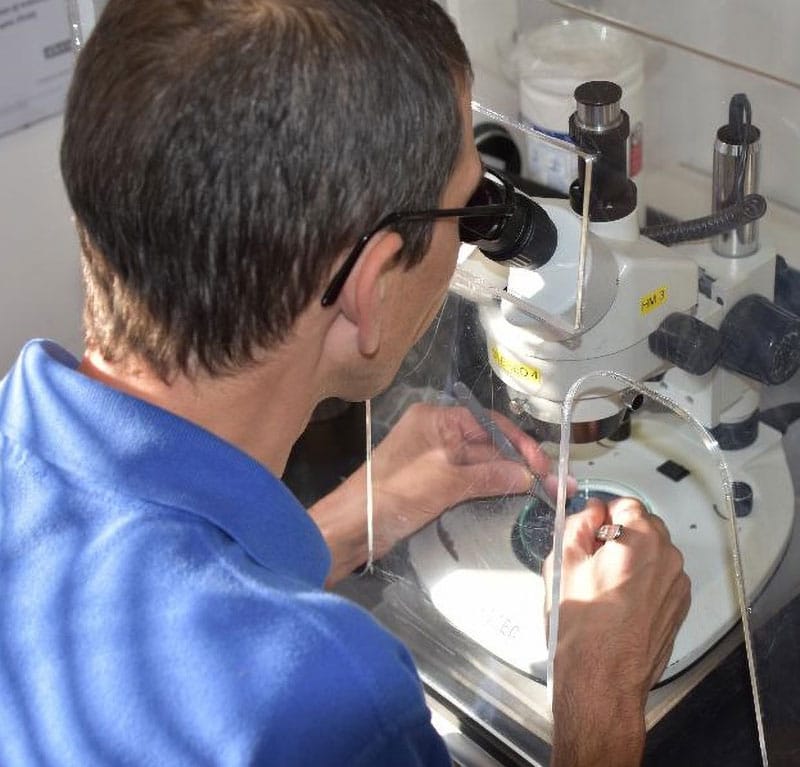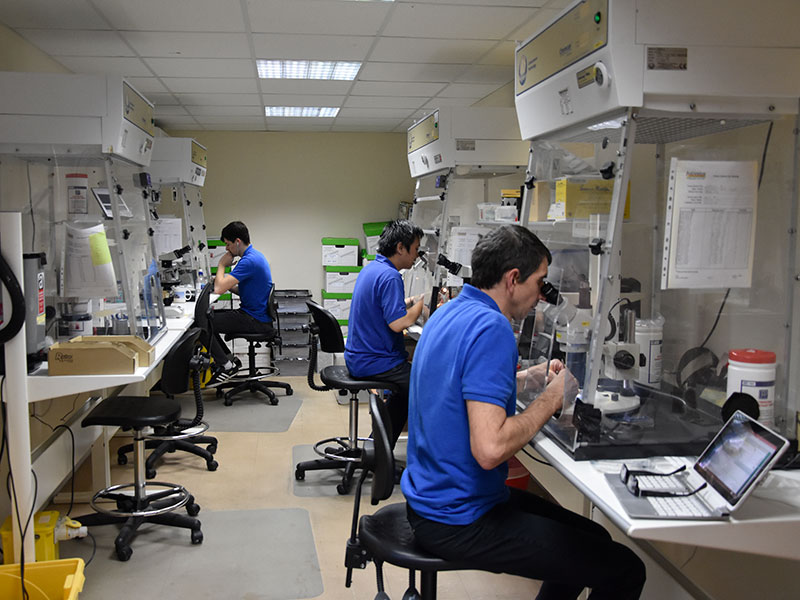What is phase contrast microscopy (PCM) in asbestos air testing?
Employers and property owners that are responsible for workplaces and other premises where asbestos-containing materials (ACMs) are suspected or confirmed to be present, have plenty of reason to arrange for the surveying, testing, and monitoring of such sites for asbestos.
Asbestos air testing, also sometimes referred to as “asbestos air monitoring”, involves a sample of the air being taken in a particular location, in order to ascertain whether the air contains potentially deadly asbestos fibres. It is carried out by highly trained and certified analysts.
There are various circumstances in which you might arrange to have asbestos air testing carried out at a particular site. You might do so, for example, following demolition or remodelling work at a location where ACMs are known to be present. Alternatively, you might enquire about this service if you are aware of damaged ACMs on the premises, and you wish to determine the extent to which asbestos fibres might have been released into the air as a result of this.
Whatever the circumstances may be in which you have asbestos air testing carried out at a given property, it is of the very greatest importance for the testing methods used to be accurate and reliable. This brings us onto the subject of phase contrast microscopy, or PCM, which is a standard technique used in the analysis of air samples for asbestos fibres.
But what exactly is PCM, and how is it applied in asbestos air testing? Below, we have set out the essentials that should be known by employers, property owners, and other dutyholders under the current UK asbestos regulations.
What is asbestos air testing?
Asbestos air testing is a process used to assess the level of asbestos fibres that may be present in the air at a particular location. There are various names or “types” of asbestos air testing, but the method used is broadly the same across these types; qualified analysts use specialist equipment to capture samples of the air, which are subsequently analysed under a microscope.
It is well-documented today that the inhalation or ingestion of asbestos fibres can pose extremely serious risks to health. Individuals who are exposed to this now-banned substance can be at risk of developing potentially fatal health conditions, such as mesothelioma or asbestos-related lung cancer, many decades after they come into contact with this fibrous silicate mineral.
This makes asbestos air testing essential for ensuring safety in a wide range of environments where ACMs are present or suspected. It can help to ensure the most informed decisions are taken, including on the control measures that may be required to help manage the risk.
The various names or “types” of asbestos air testing include:
- Asbestos reassurance air testing, which is carried out to reassure those who have reason to believe there could be a risk of airborne asbestos fibres at a particular location
- Asbestos background air testing, which is typically carried out during an activity in a location where asbestos is present, and when there may be a risk of disturbing that asbestos
- Asbestos leakage air testing, which is undertaken directly outside of an asbestos enclosure, to help ensure the safety of control measures for people who are not directly involved in the work
- Asbestos personal air testing, which is carried out on a specific person, with the aim of monitoring the personal air the given individual is breathing in during an activity where asbestos may be involved.
Phase contrast microscopy is one of the key methods for fibre analysis when asbestos air testing services like the above are required, allowing for quick and cost-effective results to be achieved.
What is phase contrast microscopy (PCM)?
Phase contrast microscopy is the standard method used for the sampling and counting of fibres in the air. The basic process entails air being drawn at a known flow rate through a filter for a measured time, which results in the collection of airborne particles.
This is followed by the filter being mounted on a glass slide and rendered transparent, thereby enabling microscopy examination. PCM of at least 500x magnification is used to examine a known fraction of the filtered deposit. This enables the counting of all fibres seen in a known number of microscope graticule areas.
Then, it will be time for the fibre concentration to be determined, in terms of fibres per millilitre of air. This is done by dividing the total number of fibres collected on the filter’s exposed area by the volume of sampled air.
What is the role of PCM in asbestos air testing?
The PCM method is used for various types of assessments that require asbestos air testing, such as exposure monitoring and clearance testing after the removal of asbestos.
With regard to the latter, a four-stage clearance process is legally required once licensed asbestos removal work is complete. This allows for a reoccupation certificate to be obtained, so that the affected area can then be reoccupied. Air testing and monitoring is the third of those four stages, with the others being preliminary checks (stage one), visual inspection of the work area or enclosure (stage three), and the final assessment and dismantling of the work area (stage four).
Although PCM is not the only method that can be used to test for asbestos fibres in the air, it has various noted advantages. It is a quick and cost-effective way to identify fibre concentrations in the air, and there isn’t even any need for specialised knowledge for the analysis to be done. So, PCM is especially often requested in situations where convenience and immediate results are paramount priorities.
What are the limitations of PCM in asbestos air testing?
It should be emphasised that PCM is by no means a complete and comprehensive means of determining the exact concentrations of asbestos in sampled air. Indeed, one of its main disadvantages is that it cannot actually distinguish between asbestos fibres and other, non-asbestos fibres. This is due to PCM’s reliance on fibre morphology (the study of the structure and form of things), rather than chemical composition.
With the PCM membrane filter method having been initially developed to measure the exposure of industrial asbestos workers, the aforementioned drawback of PCM is relatively unimportant for the monitoring of workers in the licensed asbestos removal industry.
Since then, however, the PCM method has gone on to be used for air testing in other situations where there is no current and nearby work being undertaken on ACMs. This broadening of the use of PCM has caused the limitations of this method to become more obvious over time, so you will need to take this into account when you are interpreting PCM results.
If, then, you do use the PCM method in scenarios where the concentrations of asbestos in the air are likely to be low, a significant proportion of the fibre count will inevitably be types of fibre that are not asbestos, but that nonetheless meet the shape and size criteria for asbestos. This is likely to mean the PCM fibre count is unrepresentative of the asbestos fibre concentration.
In situations like these, then, the PCM result could be interpreted as the upper limit of the possible airborne asbestos fibre concentration, rather than a definitive measure of the actual level of asbestos fibres in the sampled air.
Such limitations, however, do mean that in some situations, additional testing methods may be necessary. The transmission electron microscopy (TEM) method can provide more accurate results due to its ability to identify even the smallest asbestos fibres, while distinguishing these from non-asbestos fibres. However, it does also take longer than PCM, and is more expensive.
Nonetheless, in cases where a PCM analysis reveals a high concentration of fibres in the air, the decision is often made to follow this up with a more comprehensive TEM analysis. This allows it to be determined which portion of the overall detected fibres does contain asbestos, so that the best-informed possible decisions can be made in light of this.
When is PCM used in asbestos air testing?
The aforementioned pros and cons of PCM as a testing method, mean that it typically lends itself better to certain scenarios and stages in asbestos management, than it does to others.
One situation in which you might be especially likely to request asbestos air monitoring that uses the PCM method, is if you are looking to carry out routine surveillance of an environment where you already know ACMs to be present.
You might also arrange for PCM air testing and analysis during and after asbestos removal projects, to ensure fibre concentrations in the air are within safe limits. In addition, this method is often used as part of occupational health assessments to monitor potential exposure to asbestos.
Conclusion: the PCM method can make a major contribution to asbestos safety
In this article, we have sought to make clear the prominent and crucial part that phase contrast microscopy plays in asbestos air testing – and by extension, its importance in broader asbestos management and safety compliance.
Here at Oracle Solutions, we would always encourage individuals and businesses to prioritise accurate asbestos air testing as part of their asbestos management plan. For this reason, we recommend that you seek the professional services that will enable you to ensure the most reliable testing and analysis.
To schedule PCM asbestos air testing by our own accredited asbestos analysts, or to learn more about any of our other highly regarded asbestos services, please feel free to enquire to us online, or to give us a call today.

Written by Jess Scott
Jess Scott has been an all-round asbestos consultant since 1996. That’s nearly 3 decades of asbestos knowledge. He spends his time sharing that knowledge with the team at Oracle and with their clients. Jess's goal is, and always has been, to use my expertise in helping people to comply with the law. This legal compliance ultimately helps to protect everyone from the harmful effects of asbestos. Jess has acted as an asbestos expert witness in legal cases and is involved in many asbestos educational activities throughout the UK.


